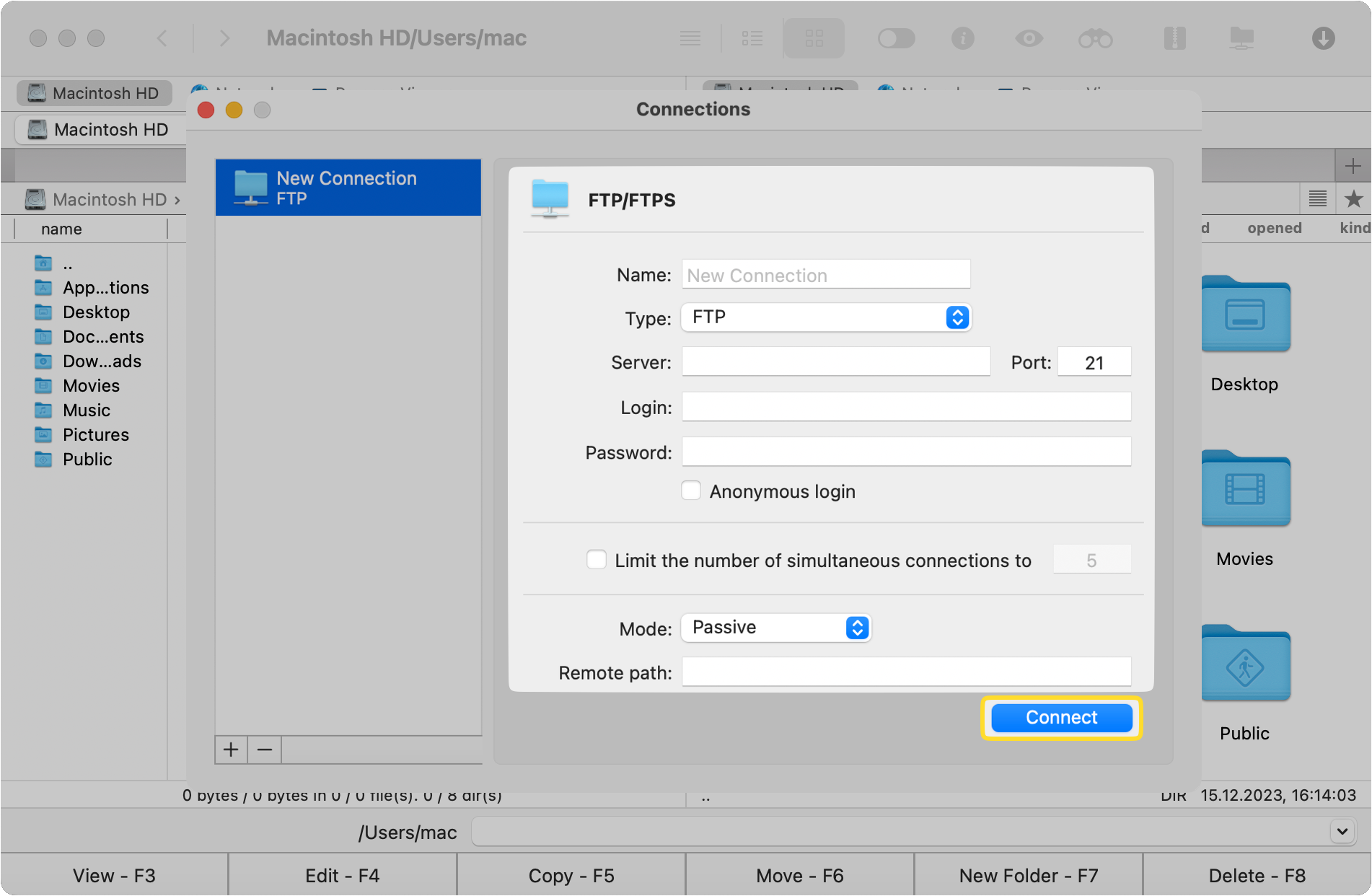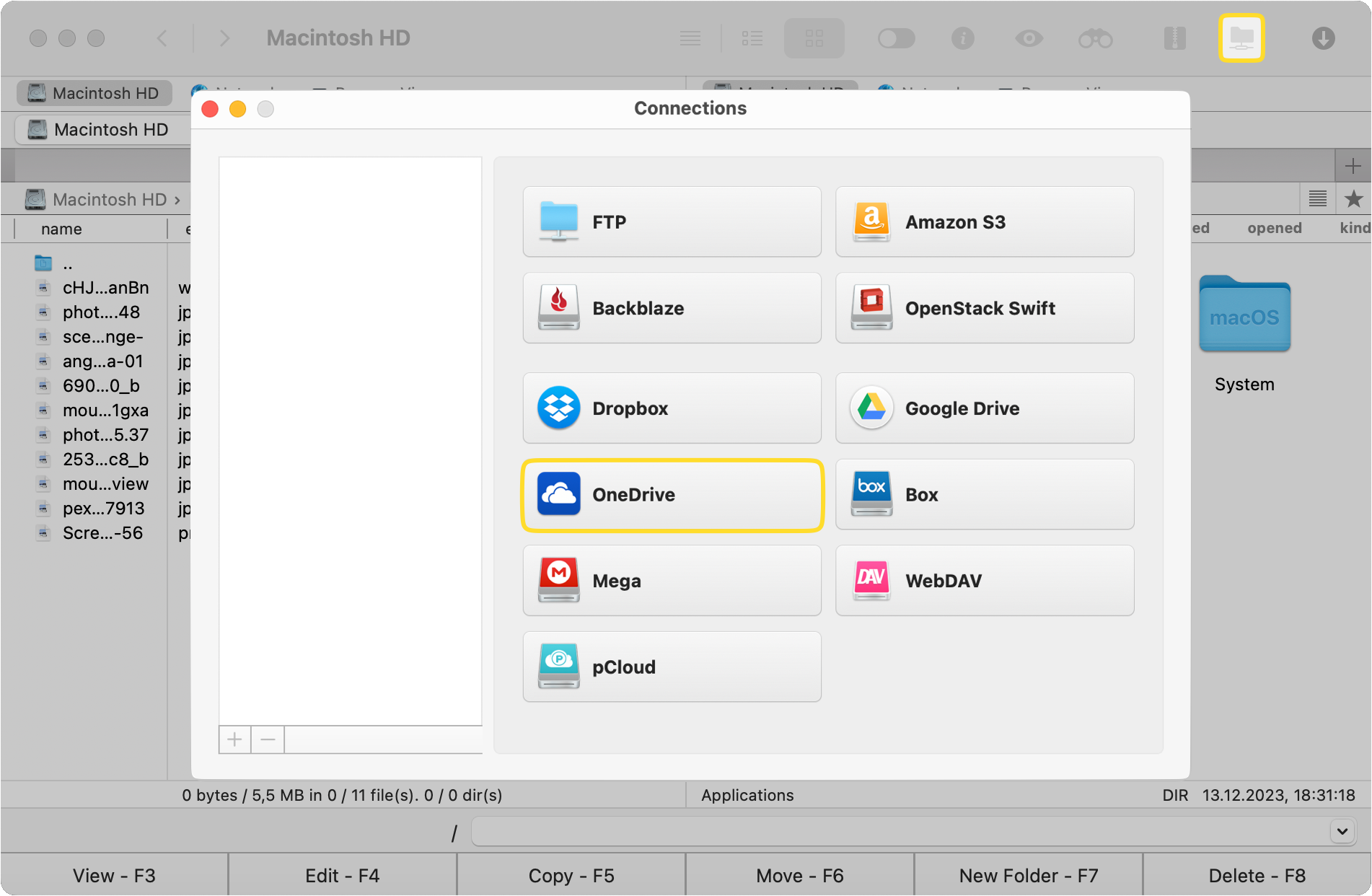OneDrive es un servicio de almacenamiento en la nube desarrollado por Microsoft. Permite que los usuarios almacenen con seguridad sus archivos importantes como documentos, fotos, vídeos y otros, haciéndolos accesibles desde casi cualquier lugar con conexión a Internet. También puede utilizar FTP con OneDrive, pero para ello es necesario una aplicación de terceros.
Si buscas un cliente fiable que reduzca distancias entre OneDrive y FTP, nosotros tenemos la solución. En este artículo, le mostraremos una de las mejores herramientas para conectar OneDrive a FTP de forma rápida y sencilla.
El Mejor Método FTP a OneDrive – Commander One
Commander One es un completo software de gestión de archivos para macOS on funciones FTP integradas. Ofrece una interfaz de doble panel fácil de usar que simplifica enormemente las operaciones de archivo. Con Commander One, puede conectar OneDrive como unidad de red en Mac, así como sus otras cuentas en la nube y servidores FTP, y acceder y editar fotos, documentos, presentaciones y hojas de cálculo en línea directamente desde el escritorio de su Mac sin tener que sincronizar los archivos con la nube ni descargarlos en su ordenador.
Commander One es también la mejor manera de transferir archivos FTP a OneDrive. Ya no tendrá que descargar y volver a cargar archivos manualmente – Commander One le ayuda a compartir archivos directamente con unos pocos clics. Las transferencias de archivos se realizan con solo arrastrar y soltar entre dos paneles en la aplicación.
¿Cómo Transferir Archivos del Servidor FTP a OneDrive y Viceversa?
Descargue e instale Commander One.
Abra la aplicación y acceda al gestor de “Conexiones”. A continuación, seleccione una conexión FTP de la lista.

A continuación, especifique el nombre de la conexión, la dirección del servidor, el puerto, las credenciales FTP y la ruta remota. Seleccione el modo: activo o pasivo.

Ahora debe conectarse a su cuenta de OneDrive. Para ello, vuelva a abrir el gestor de “Conexiones” y seleccione “OneDrive”. Conéctese a su cuenta.

Una vez conectado, verá todos sus archivos y carpetas en la ventana de doble panel de Commander One.

Ahora puede transferir los archivos de la cuenta FTP a OneDrive a través de uno de los siguientes métodos:
- arrastrar y soltar
- copiar/pegar
- pulsar la tecla F5 del teclado
- pulsar el botón “Copiar-F5” en la interfaz.
Consejos Útiles
Diferencia entre OneDrive y un Servidor FTP
Tanto un servidor FTP (File Transfer Protocol) como OneDrive son métodos para almacenar y compartir archivos, pero tienen algunas diferencias. Veámoslas.
Un servidor FTP (también conocido como FTP host) es un ordenador que tiene una dirección FTP (File Transfer Protocol) y está diseñado para aceptar conexiones FTP. Almacena archivos y permite cargar y descargar archivos al/desde el servidor utilizando aplicaciones de terceros. Para conectarte al servidor FTP, es necesario disponer de la siguiente información: nombre de usuario, contraseña y dirección del servidor. También hay servidores FTP que no necesitan credenciales. Suelen ser servidores FTP anónimos o públicos diseñados para efectuar pruebas.
Se puede acceder a FTP a través de un navegador web, utilizando Finder o a través de un cliente FTP, que ofrece mayor flexibilidad y más características y funcionalidades en comparación con otros métodos.
OneDrive es una plataforma de almacenamiento en la nube que permite almacenar archivos y acceder a ellos desde diferentes dispositivos con conexión a Internet. Se integra fácilmente con las herramientas de Microsoft Office 365, por lo que es más cómodo colaborar en documentos, hojas de cálculo y presentaciones en tiempo real.
En resumen, los servicios en la nube ofrecen más ventajas que el FTP. Son fáciles de usar y garantizan un acceso instantáneo a los archivos almacenados en la nube, mientras que el FTP suele exigir una configuración y un software específico.
Razones para Mover Datos del Servidor FTP a OneDrive
Aunque los servidores FTP son fáciles de usar para los expertos en tecnología, la mayoría de los usuarios comunes consideran que utilizar los clientes y servidores FTP lleva mucho tiempo y es complicado. Las configuraciones complejas y la necesidad de software adicional a menudo hacen que los usuarios acaben sintiéndose desbordados.
El almacenamiento en la nube, en cambio, es más fácil de usar y accesible y no exige grandes conocimientos técnicos. Esto lo convierte en la mejor opción para particulares y organizaciones.
Tamaño de los Archivos Cargados en Microsoft OneDrive
Existen algunas limitaciones en el tamaño de los archivos subidos a OneDrive. En 2021, Microsoft aumentó el límite de subida de archivos anterior a 250 GB. Estos límites se aplican a los archivos y no afectan a la capacidad total de almacenamiento. Para archivos de gran tamaño, se recomienda utilizar la app de OneDrive.
Conexiones Alternativas Soportadas por Commander One
La lista de servicios de almacenamiento en la nube compatibles con Commander One es muy amplia. Incluye todos los servicios populares como Dropbox, Google Drive, Amazon S3, Backblaze B2, etc. También es compatible con el protocolo WebDAV. Con Commander One, todas sus cuentas en la nube y servidores remotos están en un solo lugar y son fácilmente accesibles.
Preguntas Frecuentes
Commander One es un gestor de archivos de doble panel para Mac. Le permite realizar varias operaciones de archivos, acceder y gestionar unidades en la nube y servidores de red. También ofrece funciones avanzadas como cliente FTP/SFTP, gestión de archivos y otras muchas para gestionar los archivos de forma eficiente.
Commander One tiene dos versiones: FREE y PRO. La versión FREE incluye un visor integrado, varios métodos de búsqueda y opciones de clasificación, compatibilidad con archivos ZIP, etc., mientras que la versión PRO desbloquea funciones avanzadas como compatibilidad con FTP, emulador de Terminal y la posibilidad de montar cuentas de almacenamiento en la nube y gestionar archivos en línea.